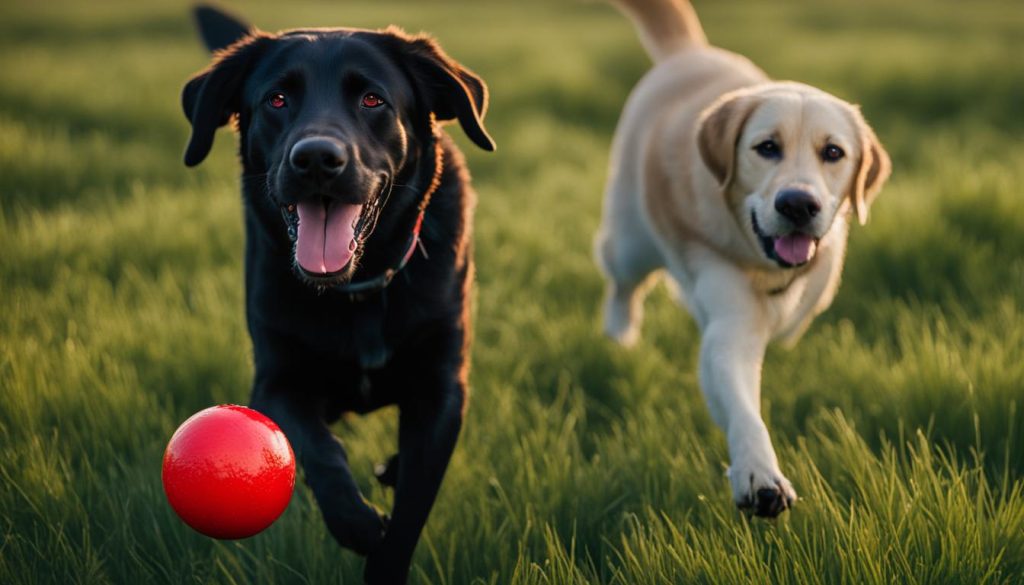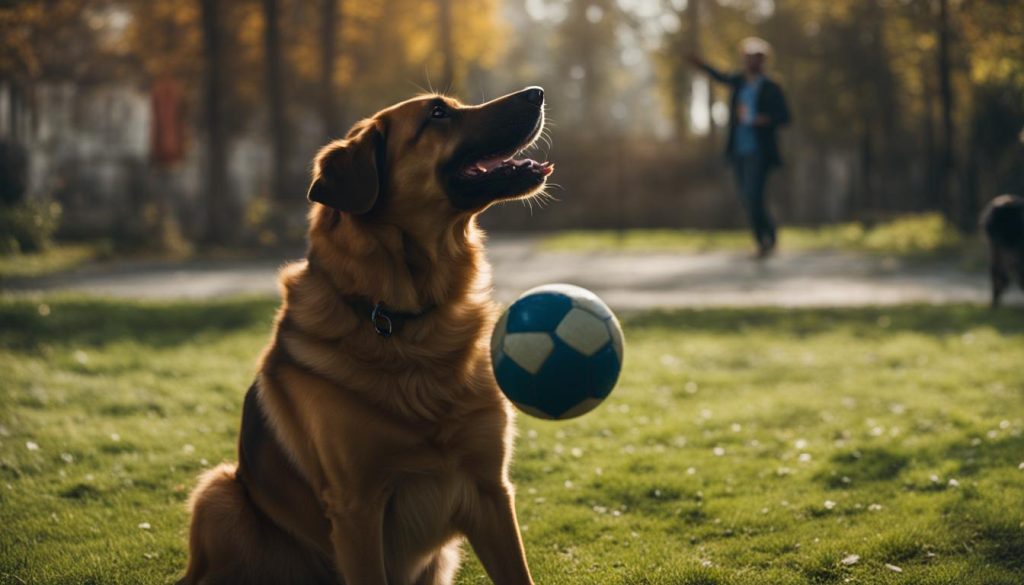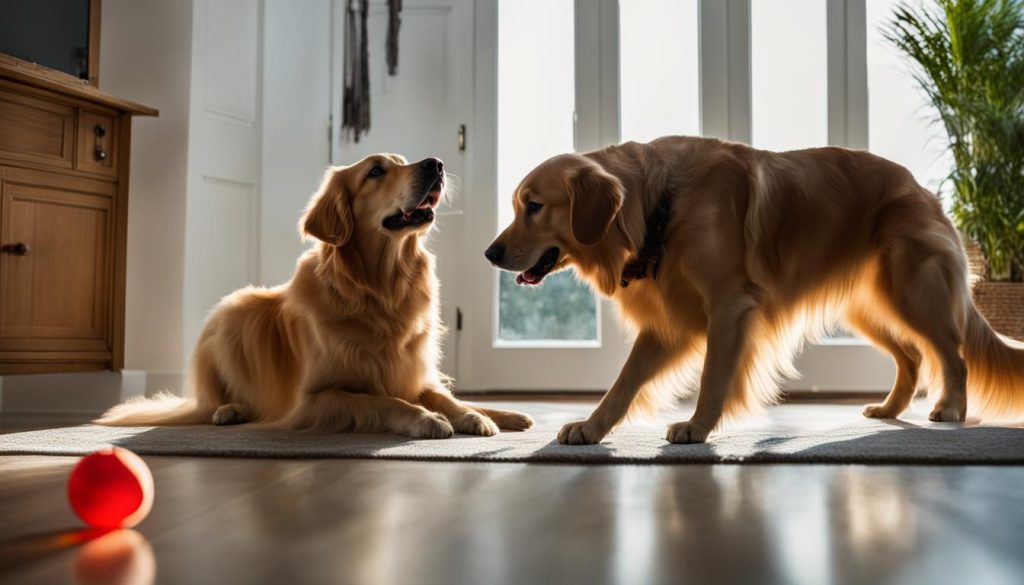Teaching your dog to release the ball is an important skill that can enhance their obedience and make games of fetch more enjoyable. German shepherds, known for their high prey drive, naturally love chasing a ball. Playing fetch provides numerous benefits, including physical exercise, mental stimulation, and improved bonding between dog and owner. However, some dogs may struggle with returning the ball and dropping it. With patience and training, you can teach your dog to release the ball on command, ensuring a fun and rewarding game of fetch.
Key Takeaways
- Teaching your dog to release the ball enhances their obedience and makes games of fetch more enjoyable.
- Playing fetch offers physical exercise, mental stimulation, and improved bonding between dog and owner.
- Some dogs may struggle with returning the ball and dropping it, but with patience and training, you can teach them to release the ball on command.
- German Shepherds, known for their high prey drive, naturally love chasing a ball.
- Fetch provides numerous benefits, including physical exercise, mental stimulation, and improved coordination.
Benefits of Playing Fetch with Your Dog
Playing fetch with your dog offers various benefits. It is a fun and rewarding activity that can make your dog happy and provide an outlet for their high energy levels. Fetch is an excellent form of exercise, especially when physical walks or runs aren’t possible. It also offers mental stimulation, preventing boredom and destructive behavior. Through fetch, you can strengthen your dog’s focus, training, and discipline. Additionally, playing fetch improves coordination, helps alleviate stress and anxiety, and promotes better indoor behavior. This activity is suitable for most people, and tools are available to accommodate physical limitations.
Benefits of Playing Fetch with Your Dog
- Fun and rewarding activity for both dogs and owners
- Provides physical exercise and mental stimulation
- Strengthens focus, training, and discipline
- Improves coordination and indoor behavior
- Alleviates stress and anxiety
- Suitable for people with physical limitations
Playing fetch with your dog is not only enjoyable but also beneficial for their overall well-being. It engages them physically and mentally, keeping them active and entertained. The act of chasing and retrieving the ball stimulates their natural instincts and helps burn off excess energy. This is particularly helpful for high-energy breeds or dogs that have a tendency to become bored or destructive when not properly exercised.
In addition to the physical benefits, fetch also provides mental stimulation. Dogs need mental exercise just as much as physical exercise to keep their minds sharp and prevent boredom. Teaching them to follow fetch commands and retrieve the ball helps improve their focus, training, and discipline. It challenges their problem-solving skills and strengthens the bond between you and your furry companion.
Playing fetch with your dog is a win-win situation. It allows them to expend energy, both physically and mentally, while providing an opportunity for training and bonding. It’s a fun and interactive way to strengthen your relationship and create lasting memories with your canine friend.
Furthermore, fetch can have a positive impact on your dog’s behavior indoors. By engaging in regular fetch sessions, you provide them with an acceptable outlet for their energy, reducing the likelihood of destructive behavior such as chewing or digging. It also helps alleviate stress and anxiety, as the physical activity and mental stimulation release endorphins, promoting a sense of well-being and relaxation.
playing fetch can be adapted to accommodate different physical abilities. If you have limited mobility or other physical limitations, there are tools available, such as ball launchers, that can help with throwing the ball. This allows you to still engage in fetch with your dog and provide them with the exercise and mental stimulation they need.

Summary
Playing fetch with your dog offers numerous benefits, including physical exercise, mental stimulation, improved focus and discipline, better indoor behavior, stress relief, and strengthened bond. It is a fun and interactive activity that can be enjoyed by both dogs and their owners. With the right tools and adaptations, fetch can be enjoyed by people with physical limitations as well. So, grab a ball, head to the park or your backyard, and enjoy a game of fetch with your furry friend!
Teaching Basic Commands for Fetch
Before teaching your dog to release the ball, I would advise that you ensure they know basic commands such as “drop it.” Start by offering the ball to your dog and asking them to drop it while holding your hand out with a treat. Praise or use a clicker to mark the behavior when they drop the ball and reward them with the treat. Practice this command until your dog reliably drops the ball on command. Once they understand the drop command, you can proceed to teaching them to retrieve and return the ball.
Teaching Basic Commands for Fetch
Teaching your dog to drop the ball is an essential step in ball retrieval training. It starts with familiarizing your dog with the “drop it” command. Offer the ball to your dog and ask them to drop it while you hold your hand out with a treat. Praise or use a clicker to mark the behavior when they drop the ball and immediately reward them with the treat. Repeat this exercise until your dog consistently drops the ball on command.
Once your dog understands the drop command, you can progress to the next step of teaching them to retrieve and return the ball. This involves tossing the ball a short distance and calling your dog back to you. As they approach, ask them to drop the ball using the command you previously taught. Praise and reward them when they comply. With repetition and positive reinforcement, your dog will learn to drop the ball on command, making the game of fetch more enjoyable for both of you.
To put it simply, consistency and patience are key when teaching your dog basic commands for fetch. Be sure to practice in a calm and distraction-free environment to help your dog focus on the learning process. With time and positive reinforcement, your dog will become proficient in dropping the ball, setting the foundation for successful ball retrieval training.

Step-by-Step Guide for Teaching Your Dog to Release the Ball
Teaching your dog to release the ball is an essential part of fetch training. By following these steps, you can effectively teach your dog to let go of the ball on command.
Step 1: Start indoors
Begin the training process indoors, in a quiet and familiar environment. Gently toss the ball a few feet away from you and call your dog back. As they approach, ask them to sit and hold out your hand, using the command “drop it.” When your dog releases the ball into your hand, provide immediate praise and a treat as a reward.
Step 2: Move outdoors
Once your dog consistently releases the ball indoors, it’s time to progress to outdoor training. Find a safe and enclosed outdoor space, such as a fenced yard or a quiet park. Repeat the same process of tossing the ball, calling your dog back, and asking them to sit and drop the ball. Reward their successful release with praise and a treat.
Step 3: Eliminate treats
As your dog becomes more proficient in releasing the ball, you can gradually phase out the use of treats. Instead, use the act of fetching the ball itself as the reward. Continue to praise and reinforce the release behavior with verbal cues and physical affection. This helps your dog understand that releasing the ball leads to more playtime and fun.

To put it simply, consistency and patience are key when teaching your dog to release the ball. Celebrate their successes and offer support and guidance during the learning process. With practice and positive reinforcement, your dog will master this important skill, making games of fetch more enjoyable for both of you.
Reinforcing the Release Behavior
To reinforce the release behavior in your dog, you should keep the game of fetch interesting and enjoyable. One way to do this is by throwing different balls, toys, or flying discs during playtime. This variety will not only engage your dog’s curiosity but also prevent them from becoming bored or disinterested. Try to use positive reinforcement techniques, such as praise or a clicker, each time your dog successfully releases the ball.
Consistency is key when reinforcing the release behavior. By consistently rewarding your dog for dropping the ball, they will begin to associate this action with positive outcomes. Over time, your dog will come to understand that releasing the ball leads to more fun playtime and exercise, providing motivation for them to continue practicing this behavior.
“The joy of training a dog lies in their ability to learn and adapt. By reinforcing the release behavior, we can strengthen their obedience and deepen the bond between human and canine.” – Professional Dog Trainer
To put it simply, patience is crucial throughout the training process. Dogs may take varying amounts of time to fully grasp the concept of releasing the ball. Be consistent in your training efforts and offer positive reinforcement consistently for successful releases. With time, your dog will become proficient in letting go of the ball, making fetch an enjoyable and rewarding experience for both of you.

Tips for reinforcing the release behavior:
- Use high-value treats to reward your dog for releasing the ball.
- Keep training sessions short and frequent to maintain interest and focus.
- Use an enthusiastic tone and body language to encourage your dog during the training process.
- Always play fetch in a safe and secure space to prevent accidents or injuries.
- Be patient and consistent with your training efforts, understanding that every dog learns at their own pace.
| Command | Technique | Outcome |
|---|---|---|
| Drop It | Offer a treat while asking your dog to drop the ball | Teaches your dog to release the ball on command |
| Variety in Toys | Use different balls, toys, or flying discs during playtime | Keeps the game of fetch engaging and prevents boredom |
| Positive Reinforcement | Use praise or a clicker to reward your dog for releasing the ball | Strengthens the association between releasing the ball and positive outcomes |
Teaching Fetch in an Enclosed Space
When it comes to teaching your dog to fetch, starting in an enclosed space can be highly beneficial. Whether it’s a hallway or a fenced backyard, an enclosed area helps your dog focus on you and the task at hand. With fewer distractions and limited space to run off, your dog is more likely to learn and practice fetch commands effectively. It provides an environment conducive to concentration and learning, laying a strong foundation for successful fetch training.

Benefits of Teaching Fetch in an Enclosed Space
1. Improved Focus: In an enclosed space, your dog has fewer potential distractions, allowing them to concentrate on the game of fetch and the commands you give.
2. Enhanced Safety: Playing fetch in an enclosed area ensures that your dog remains contained, minimizing the risk of them running off or encountering any hazards.
3. Controlled Environment: An enclosed space allows you to set the scene for successful training sessions. You can easily position yourself, adjust throwing distances, and create a structured environment for your dog to learn.
By starting fetch training in an enclosed space, you provide a controlled setting for your dog to understand the concept and build a strong foundation for future fetch training sessions.
Tips for Successful Fetch Training
When it comes to teaching your dog to release the ball during fetch training, positive reinforcement is key. Here are some tips to help you achieve success:
- Use high-value treats: Reward your dog with tasty treats when they drop the ball on command. This reinforces the behavior and motivates them to continue releasing the ball.
- Short and frequent training sessions: Keep your training sessions brief to maintain your dog’s interest and focus. Regular practice helps them retain the commands and progress more effectively.
- Enthusiastic tone and body language: Your dog picks up on your energy, so use an enthusiastic tone and positive body language to encourage them during the training process. This creates a positive and engaging environment for learning.
“Positive reinforcement is a powerful tool in dog training. By rewarding your dog for releasing the ball, you’re reinforcing the desired behavior and building a strong bond of trust and communication.” – Professional Dog Trainer
I recommend that you play fetch in a safe and secure space to prevent accidents or injuries. Choose an area that is free from hazards and distractions, allowing your dog to focus solely on the training. To put it simply, every dog learns at their own pace, so be patient and consistent in your efforts. With time and effort, your dog will become proficient in releasing the ball, making fetch an enjoyable and rewarding experience for both of you.
| Positive Reinforcement | Canine Ball Training | Training Tricks for Dogs |
|---|---|---|
| Uses rewards and praise to encourage desired behavior. | Teaches dogs to interact with and retrieve balls. | Offers various techniques for training dogs. |
| Strengthens the bond between dog and owner. | Enhances obedience and discipline. | Provides mental stimulation and exercise. |
| Boosts confidence and promotes better behavior. | Improves coordination and focus. | Prevents boredom and destructive habits. |
Troubleshooting Common Challenges in Teaching Fetch
Teaching your dog to release the ball on command can sometimes come with challenges. Dogs may become possessive of the ball and refuse to let go, leading to frustrating moments during training sessions. However, with the right approach and positive reinforcement techniques, you can overcome these common challenges and successfully teach your dog to drop the ball on command.
Challenging Possessiveness:
If your dog becomes possessive of the ball and doesn’t want to release it, address this behavior early on. One effective method is to trade the ball for a high-value treat. Offer your dog the treat as a trade-off for the ball, and once they drop the ball, reward them with the treat and praise. This helps them associate releasing the ball with a positive outcome and encourages them to let go willingly.
Using Distractions:
Another strategy to overcome possessiveness is to introduce distractions. Engage your dog’s attention by using another toy or treat while asking them to drop the ball. This diverts their focus away from the possessive behavior and encourages them to release the ball. With consistent practice, your dog will learn that dropping the ball leads to more fun and rewarding playtime.
Consistency and Patience:
Consistency is key when teaching your dog to release the ball. Set clear rules and expectations from the beginning, and stick to them throughout the training process. Reinforce positive behavior with treats, praise, and a cheerful tone of voice. Try to be patient and understanding, as every dog learns at their own pace. With consistency, patience, and positive reinforcement, you will successfully teach your dog to drop the ball and enjoy a game of fetch to the fullest.
| Common Challenges | Solutions |
|---|---|
| Possessiveness of the ball | – Trade the ball for a high-value treat – Use distractions to divert their attention – Reinforce positive behavior with praise |
| Reluctance to let go of the ball | – Offer a trade-off with another toy or treat – Engage in play sessions with multiple toys – Maintain consistency and patience in training |
| Slow progress in learning to release the ball | – Break down the training into smaller steps – Practice in a low-distraction environment – Use positive reinforcement consistently |
To put it simply, teaching your dog to release the ball takes time and effort. By addressing possessiveness, introducing distractions, and maintaining consistency, you will overcome these common challenges and enjoy a game of fetch with your furry friend.

Final Thoughts
Teaching dogs to let go of the ball and using dog ball release techniques is a crucial aspect of fetch training. By employing positive reinforcement methods, you can successfully train your dog to drop the ball on command, enhancing their obedience and overall enjoyment of the game. Throughout the step-by-step guide, we have emphasized the importance of patience, consistency, and tailoring the training to your dog’s needs.
To put it simply, every dog learns at their own pace, so I would advise that you be patient and understanding. By reinforcing positive behavior through treats, praise, and toys, you can overcome challenges and encourage your dog to release the ball willingly. The bond between you and your dog will strengthen as you engage in fun and rewarding games of fetch.
Incorporating positive reinforcement techniques, such as using high-value treats and maintaining an enthusiastic tone, will significantly contribute to the success of the training. Consistent training sessions, performed in safe and secure spaces, will help your dog understand and respond to the fetch commands effectively. Be sure to keep the training sessions short but frequent, maintaining your dog’s interest and focus throughout.
By following the tips and guidelines provided, you can master the art of teaching dogs to let go of the ball. With time and effort, your dog will become proficient in releasing the ball on command, turning each game of fetch into an enjoyable and rewarding experience for both of you.
FAQ
What are the benefits of playing fetch with your dog?
Playing fetch provides physical exercise, mental stimulation, and improved bonding between dog and owner. It also helps strengthen focus, training, and discipline, improves coordination, alleviates stress and anxiety, and promotes better indoor behavior.
How do I teach my dog to release the ball?
Start by teaching your dog the basic “drop it” command. Once they understand the drop command, gradually introduce retrieving and returning the ball. Reward them for dropping the ball on command and eliminate treats as they become consistent with the behavior.
Where should I start teaching fetch to my dog?
It is helpful to start in an enclosed space, such as a hallway or fenced backyard, to help your dog remain focused. Once they understand the basics of fetch in an enclosed area, you can gradually move to larger spaces.
How can I reinforce the release behavior in fetch training?
You can reinforce the release behavior by using different balls or toys during the game, providing positive reinforcement such as praise or a clicker, and ensuring that releasing the ball leads to more fun playtime and exercise.
What are some tips for successful fetch training?
Use high-value treats, keep training sessions short and frequent, use an enthusiastic tone and body language, play fetch in a safe and secure space, and be patient and consistent with your training efforts.
What should I do if my dog is possessive of the ball or refuses to release it?
Focus on reinforcing positive behavior using treats, toys, and praise. Offer a high-value treat as a trade-off or play with another toy to divert their attention. Consistency, patience, and positive reinforcement will help overcome these challenges.






